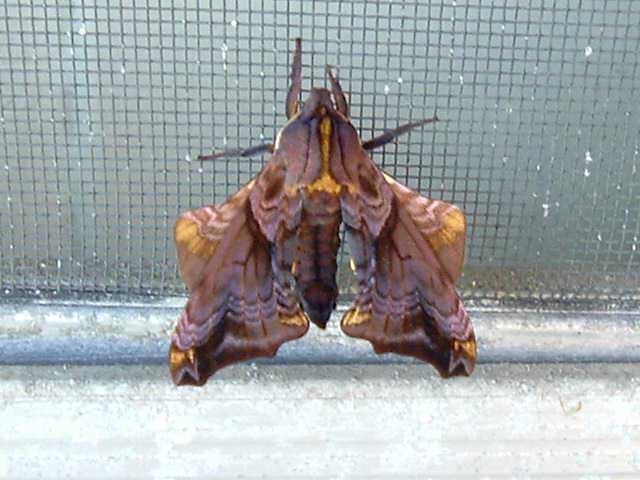Sphinginae subfamily
Sphingini tribe:
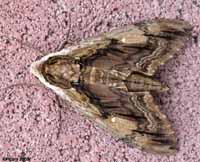 |
Ceratomia amyntor
WO,
the Elm Sphinx or Four-horned Sphinx
This moth is not officially recorded in Oakland,
but I suspect it is present.
Larvae feed on Elm (Ulmus), birch (Betula), basswood (Tilia), and
cherry (Prunus).
|
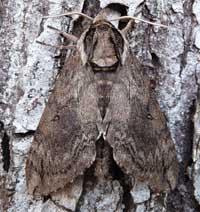 |
This is generally a more southerly species, but it has been recorded
just to the south and west of Oakland and may be present. The larvae feed in large groups and are much more
spectacular than the moths.
Catalpa is the larval host.
|
 |
This moth is recorded in Oakland County. It is named for the wavy
lines on the forewings.
|
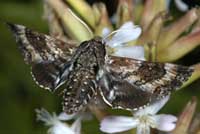 |
This moth is recorded in Oakland County.
Larve are not limited to pawpaw.
|
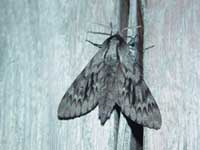 |
Although not officially reported from Oakland, it is
reported just to the northand west of Oakland and may be present.
If you have pines, you
might have this species. It flies on P.E.I.
|
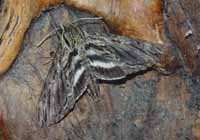 |
This species is not reported in Oakland. Generally it is not
widely reported, but still is a possibility.
|
 |
This large bodied moth flies in tobacco fields and vegetable gardens
(potatoes, tomatoes) and wherever host plants are found.
|

|
This species is not recorded in Oakland, which may be just north of its range.
If you grow tomatoes, you have possibly encountered it.
Larvae get very large and can strip a tomato plant.
|
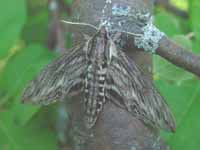
|
Sphinx canadensis
WO,
Sphinx canadensis, the Canadian Sphinx, is not common, and is not often reported anywhere,
but it might possibly be present in Oakland County.
Larval hosts are white ash (Fraxinus americana) and blueberry
(Vaccinium).
|
 |
Sphinx chersis USGS, the Northern Ash
Sphinx or Great Ash Sphinx
The upperside of the forewing is soft dark gray to blue-gray with a series of black dashes,
one of which reaches the wing tip.
|
 |
This species is present in Oakland County. We have them on P.E.I.,
but I do not see them nearly as frequently as I see the other Sphingidae.
|
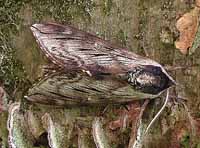 |
The upperside of the forewing ranges from brown with black borders
through brownish gray with paler borders to pale gray with no borders.
Dashes, submarginal line, and cell spot are usually weak.
|
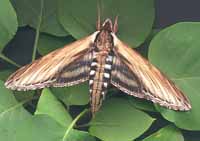 |
This species is reported in Oakland County.
I have taken them on P.E.I., Canada, and reared them on
lilac. At rest the hindwings are usually completely covered.
|
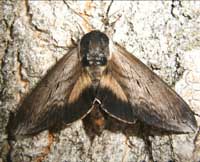 |
Sphinx luscitiosa
WO,
the Canadian Sphinx or
Clemen's Sphinx
This one is not reported from Oakland, but it might be present. generally more northerly
|
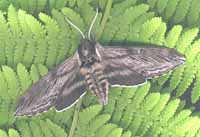 |
If you have blueberries in the woods, then you probably have the
Poecila Sphinx. They are pretty common here on Prince Edward Island,
but don't fly too far south of Massachusetts, being replaced by
Sphinx gordius in Connecticut. |
Smerinthini Tribe:
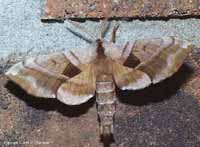 |
This moth is also reporterd in Oakland County.
This is the first Sphinx species I reared as a boy in New Jersey.
See the file for the female; she is different.
|
 |
Pachysphinx modesta
USGS,
the Modest Sphinx or Poplar Sphinx,
This large poplar/willow feeder is reported in Oakland County.
They are a heavy bodied species.
|
 |
The outer margin of the forewing is quite wavy. There is a dark cell spot and a dark oblique line mid wing from the costa almost to the
inner margin. Basic ground colour is pinkish brown. Flight would be June-July. |
 |
Paonias myops USGS/KSH,
the Small-eyed Sphinx
This small species is probably widespread and common. This species ranges across North America.
The hindwings have a small blue eyespot ringed with black on a yellow background.
|
Paonias myops male, Oakland County, Michigan, July 17, 2008, courtesy of Kimberly Strawska Hackett.
 |
Smerinthus cerisyi
WO, the Cerisyi's
Sphinx or One-eyed Sphinx, Larvae feed on poplars and willows.
Flight would be from late May-July as a single brood. I suspect it is
present.
|
 |
This moth is widely distributed and fairly common, and it is recorded in Oakland.
Along the East Coast, it flies from P.E.I. to Florida.
|
Macroglossinae subfamily
Dilophonotini Tribe:
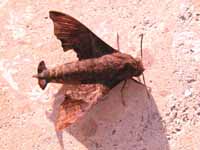 |
This moth would only be seen in Michigan as a very rare stray, probably
aided in its northward flight by strong winds after a southern storm.
|
See Hemaris comparison to help distinguish
the next three species.
 |
Hemaris diffinis USGS, the Snowberry Clearwing or Bumblebee Moth,
The moth flies along forest edges and in meadows, gardens and
brushy fields. Day-flying adults nectar at lantana, dwarf bush honeysuckle,
snowberry, orange hawkweed, thistles, lilac, Canada violet, etc.
|
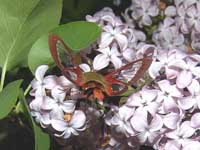 |
Hemaris gracilis WO, the
Slender Clearwing or Graceful Clearwing
Hemaris gracilis is distinguished from similar species by a pair of
red-brown bands on the undersides of the thorax, which varies from
green to yellow-green dorsally and sometimes brown with white
underneath. They have a red abdomen.
|
 |
Hemaris thysbe DS/USGS, the Hummingbird Clearwing
This interesting day flier is confirmed for Oakland.
They are widely distributed in the east from P.E.I. to Florida.
|
Philampelini Tribe:
 |
This moth is reported for Oakland,
and it is fairly often reported
along the coast from southern New Jersey
to central Maine.
Note the differences between this moth and the Pandorus Sphinx.
|
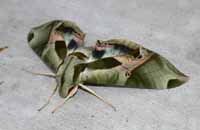 |
If you have Grape or Virginia Creeper nearby, then you probably have
this species. I often get asked to identify larvae from areas where
they have not previously been reported.
|
Macroglossini Tribe:
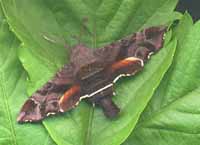 |
This day flier is widely distributed. If you have Virginia Creeper,
you probably have the Nessus Sphinx. Two bright, distinct, narrow
yellow bands are often visible on the abdomen.
|
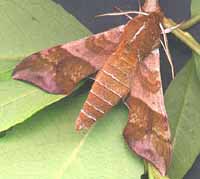 |
They are common in New Jersey and common
here on Prince Edward Island.
You will often see this species listed as Darapsa pholus,
especially in older literature.
|
 |
Darapsa myron
USGS, the Virginia Creeper Sphinx or the
Grapevine Sphinx
This moth is recorded on the U.S.G.S. site for Oakland County.
It is widely reported as far north as southern Maine. If you have the
foodplants indicated in the common names, you probably have this
species nearby.
|
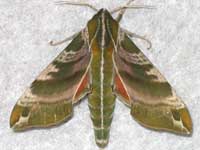 |
If you have hydrangea growing near a stream, then you may have the
Hydrnagea Sphinx. However, it
probably is uncommon.
|
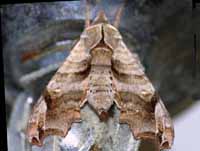 |
This species has been recorded in Oakland.
It is also seen in southern Ontario.
|
 |
Hyles gallii
WO, the Bedstraw Hawk Moth
or Gallium Sphinx
This species is not reported in Oakland, but it has been recorded in
counties just to the south and east. I suspect it is present.
Some years I see them on P.E.I., some years, I do not.
|
 |
Hyles lineata USGS, the White-lined Sphinx
Adults usually fly at dusk, during the night, and at dawn, but they
also fly during the day over a wide variety of open habitats
including deserts, suburbs, and gardens.
|
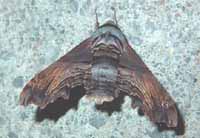 |
This moth is very much under reported on USGS. It is a
rapid day flier so is probably not in too many collections.
Grape is a popular larval host.
|
 |
This moth is much more common to the south and east. It is a strong
migrant, however, and may stray to Oakland.
|
|
|


